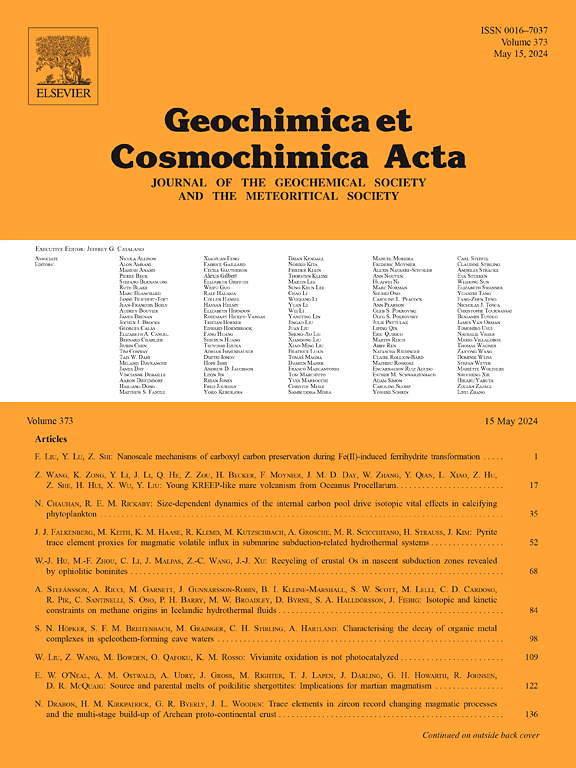基于晚渐新世至全新世碳酸盐岛的连续记录,探讨碳酸盐铀同位素作为古氧化还原代用物
IF 5
1区 地球科学
Q1 GEOCHEMISTRY & GEOPHYSICS
引用次数: 0
摘要
了解碳酸盐成岩过程中铀同位素(238U/235U,通常表示为δ238U)的分异,对于利用海洋碳酸盐定量重建地球历史上全球海底缺氧程度的变化至关重要。虽然现有的成岩格架主要基于巴哈马碳酸盐岩台地,但其稳健性和适用性需要在其他地区进行验证。由于缺乏对成岩阶段、环境和氧化还原条件对U同位素分选影响的全面研究,因此识别成岩过程中U同位素变化的替代指标的可靠性仍然不足。本研究连续采集了南海两个深钻岩心(~ 600 m XK-1岩心和 ~ 1000 m NK-1岩心)的海岛碳酸盐样品,时间横跨晚近新世至全新世(约25 Ma至今)。这些样品经历了强烈的大气和海洋成岩作用,明显缺乏有机质,为验证巴哈马成岩框架和探索识别成岩过程中U同位素变化的新地球化学工具提供了极好的机会。南海同生海水的显著正偏移(0.24 ‰±0.24 ‰,1SD, n = 152)与巴哈马的显著正偏移(0.24 ‰±0.15 ‰,1SD)相似,表明早成岩期U同位素分异在全球范围内可能是一致的。南海同沉积成岩δ238U值偏移量均匀,为0.25 ‰±0.07 ‰(1SD),与巴哈马观测值(0.26 ‰±0.10 ‰,1SD)一致,表明同沉积成岩过程中铀同位素分馏作用在不同氧化还原环境下广泛而一致地发生。沉积后成岩过程中δ238U值发生进一步的变化,沉积后海相成岩过程中的δ238U值主要由成岩流体的氧化还原条件决定。根据钒(V) -铀(U)浓度序列富集,将南海海相成岩环境中成岩流体的氧化还原条件划分为上亚氧条件和下亚氧条件。在高亚氧条件下,同时期海水的铀同位素偏移量几乎可以忽略不计,但在低亚氧条件下,由于自生铀(IV)富集,铀同位素偏移量逐渐增加约1 ‰。而成矿大气成岩过程中铀同位素偏移量(0.18 ‰±0.12 ‰,1SD)主要继承自早期同沉积成岩作用。我们在南海的新数据证实了碳酸盐岩与海水之间的一般成岩偏移为0.24 ‰±0.24 ‰(1SD),并根据其成岩阶段、环境和氧化还原条件确定了个别样品的特定偏移,这可以通过碳酸盐岩的V-U序列富集来定量评价本文章由计算机程序翻译,如有差异,请以英文原文为准。
Closing in on carbonate uranium isotopes as a paleo-redox proxy based on continuous records from Late Oligocene to Holocene island carbonates
Understanding the fractionation of uranium isotopes (238 U/235 U, commonly denoted as δ238 U) during carbonate diagenesis is crucial for quantitatively reconstructing the variations in global seafloor anoxic extent throughout Earth’s history using marine carbonates. While the existing diagenetic framework is primarily based on the Bahamian carbonate platform, its robustness and applicability need validation in other regions. The reliability of proxies for recognizing U isotope alteration during diagenesis remains inadequate due to the lack of comprehensive investigations into the influence of diagenetic stages, environments, and redox conditions on U isotope fractionation. In this study, island carbonate samples were continuously collected from two deep drill cores (∼600 m XK-1 core and ∼ 1000 m NK-1 core) in the South China Sea, spanning from the Late Oligocene to Holocene (ca. 25 Ma to present). These samples, which underwent intensive meteoric and marine diagenesis, were notably devoid of organic matter, providing an excellent opportunity to validate the Bahamian diagenetic framework and to explore new geochemical tools for recognizing U isotope alterations during diagenesis. The observed significant positive offset from contemporaneous seawater in the South China Sea (0.24 ‰ ± 0.24 ‰, 1SD, n = 152) is similar to that found in the Bahamas (0.24 ‰ ± 0.15 ‰, 1SD), indicating that U isotope fractionation during early diagenesis is likely consistent on a global scale. The δ238 U values associated with syndepositional diagenesis in the South China Sea exhibit a uniform offset of 0.25 ‰ ± 0.07 ‰ (1SD), consistent with those observed in the Bahamas (0.26 ‰ ± 0.10 ‰, 1SD), suggesting uranium isotope fractionation during syndepositional diagenesis occurs extensively and consistently across different redox environments in shallow-water carbonates. However, the δ238 U values undergo further alteration during post-depositional diagenesis, with these values during post-depositional marine diagenesis being mainly determined by the redox conditions of the diagenetic fluids. Based on the sequential enrichment of vanadium (V)–uranium (U) concentrations, we classified the redox conditions of the diagenetic fluids within marine diagenetic environments into upper suboxic and lower suboxic conditions in the South China Sea. The uranium isotope offset from contemporaneous seawater is nearly negligible under upper suboxic conditions but progressively increases by about 1 ‰ due to the authigenic U(IV) enrichment under lower suboxic conditions. However, the uranium isotope offset (0.18 ‰ ± 0.12 ‰, 1SD) during eogenetic meteoric diagenesis is primarily inherited from the earlier syndepositional diagenesis. Our new data from the South China Sea confirm a general diagenetic offset of 0.24 ‰ ± 0.24 ‰ (1SD) between carbonates and seawater, with specific offsets for individual samples determined by their diagenetic stages, environments, and redox conditions, which can be quantitatively evaluated through V–U sequential enrichments in carbonates
求助全文
通过发布文献求助,成功后即可免费获取论文全文。
去求助
来源期刊

Geochimica et Cosmochimica Acta
地学-地球化学与地球物理
CiteScore
9.60
自引率
14.00%
发文量
437
审稿时长
6 months
期刊介绍:
Geochimica et Cosmochimica Acta publishes research papers in a wide range of subjects in terrestrial geochemistry, meteoritics, and planetary geochemistry. The scope of the journal includes:
1). Physical chemistry of gases, aqueous solutions, glasses, and crystalline solids
2). Igneous and metamorphic petrology
3). Chemical processes in the atmosphere, hydrosphere, biosphere, and lithosphere of the Earth
4). Organic geochemistry
5). Isotope geochemistry
6). Meteoritics and meteorite impacts
7). Lunar science; and
8). Planetary geochemistry.
 求助内容:
求助内容: 应助结果提醒方式:
应助结果提醒方式:


